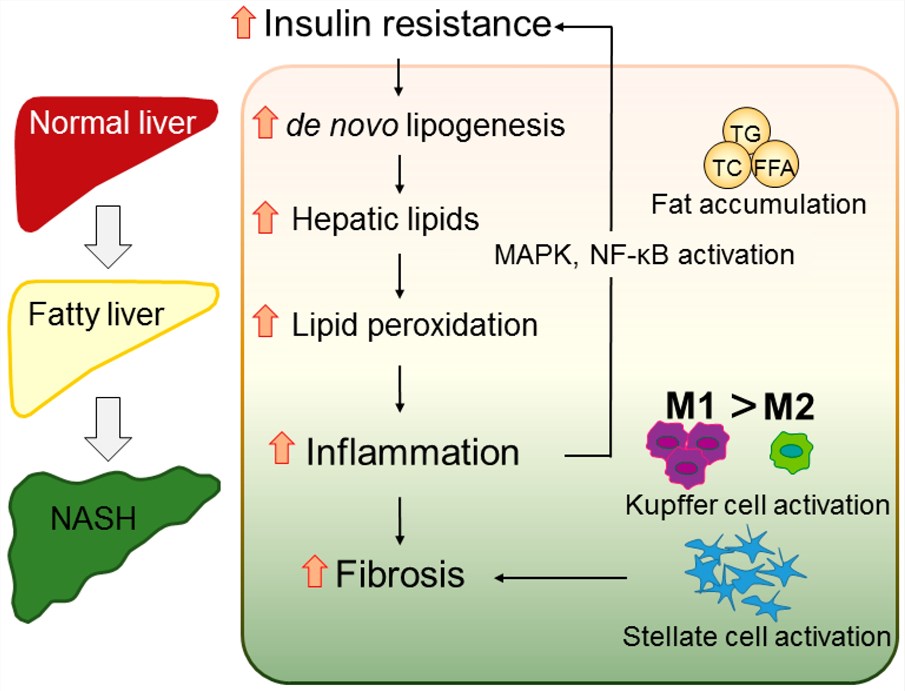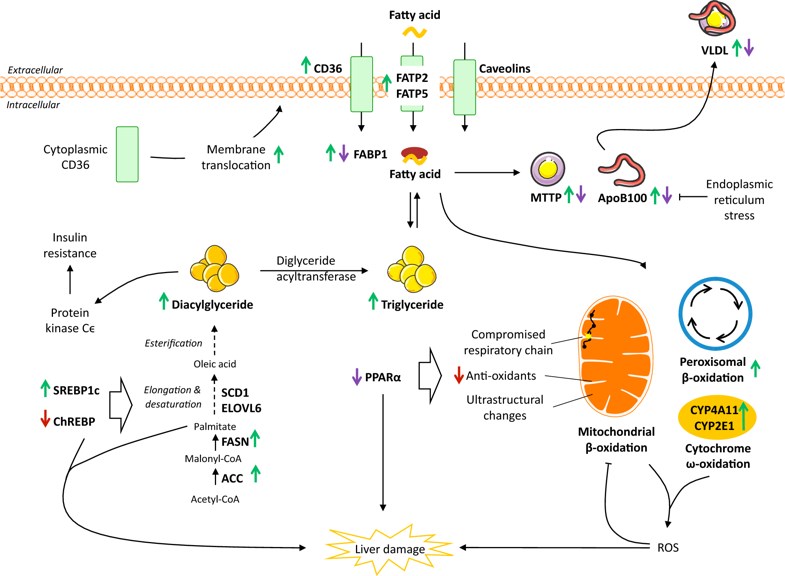NASH Target Development Services for Lipid-Altering Agents
Lipid-altering drug induced lipid-lowering is established as a proven intervention to reduce steatosis and nonalcoholic steatohepatitis (NASH) formation. Based on rich experience and advanced equipment, Creative Biolabs has won good reputation in small molecule drug discovery, screening, characterization and optimization services. Currently, our experienced scientists are dedicated to offering a wide range of lipid-altering agents as potential targets for the treatment of NASH
Lipid-Altering Agents and NASH
Lipid-altering agents are a diverse group of pharmaceuticals that can regulate lipid metabolism and control the serum levels of cholesterol profile. NASH causes liver fibrosis that can progress to cirrhosis and hepatocellular carcinoma, while this disease is closely linked to dyslipidemia, particularly the decrease of serum levels of high-density lipoprotein (HDL) cholesterol, the increase of low-density lipoprotein (LDL) cholesterol levels and hypertriglyceridemia. About the pathogenesis, an earlier concept is that excess lipid (steatosis) is the basis for NASH (“first hit”), and the injurious/proinflammatory factor (“second hit”) is required to transform steatosis to steatohepatitis. In addition, the closely linked metabolic disorders favor the hepatic accumulation of lipid species that injure liver cells and promote inflammation and fibrosis, which also contributes to NASH. Thus, the agents associated with reduced hepatic fat content or LDL cholesterol may be appropriate therapeutic targets for NASH.
 Fig.1 Hypothetic mechanism of NAFLD/NASH progression. (Chen, 2016)
Fig.1 Hypothetic mechanism of NAFLD/NASH progression. (Chen, 2016)
Lipid-Altering Agents Developments at Creative Biolabs
The public health and economic impacts of NASH have provoked intense interest in disease target identification and drug development. More robust and durable effects of NASH pharmacotherapy must be demonstrated and linked to improvement in clinical outcomes, including reduced progression to cirrhosis, complications of end-stage liver disease, need for transplantation and hepatocellular carcinoma.
At Creative Biolabs, we have developed a range of versatile, flexible, and powerful platforms for the validation of predictive biomarkers and the discovery of more effective therapies for NASH. The hotspots of lipid-altering agents include but not limited to:
-
Stearoyl-CoA Desaturase (SCD) Inhibitors
Stearoyl-CoA desaturase-1 (SCD-1) catalyzes the biosynthesis of monounsaturated fatty acids, and its abnormality is associated with obesity, insulin resistance, hepatic steatosis, and NASH. Thus, SCD-1 inhibitors can ameliorate hepatic triglyceride accumulation, liver injury, hepatocellular degeneration and inflammation in NASH. -
Acetyl-CoA Carboxylase (ACC) Inhibitors
ACC is a complex multifunctional enzyme system that catalyzes the malonyl-CoA formation by ATP-dependent carboxylation of acetyl-CoA. ACC inhibition may decrease hepatic steatosis, inflammation, and insulin resistance, supporting ACC inhibitors as potentially attractive therapeutic targets in NASH. -
Carcinoembryonic Antigen Cell Adhesion Molecule 1 (CEACAM1) Activators
CEACAM1 is a differentiation antigen involved in the maintenance of epithelial polarity that is induced during hepatocyte differentiation and liver regeneration. As a promising therapeutic strategy, CEACM1 activators can improve the biochemical characteristics of fibrous steatohepatitis (macrosteatosis, inflammation, apoptosis, necrosis and fibrosis) progressing to NASH. -
HMG-CoA Reductase Inhibitors
HMG-CoA reductase inhibitors (also known as statins) are a class of lipid-lowering medications that can block the enzyme activity of HMG-CoA reductase and then reduce the synthesis of mevalonate and cholesterol. Statins can block the committed step in cholesterol biosynthesis, showing constant values in the treatment of NASH. -
11 β-Hydroxysteroid Dehydrogenase Type1 (11 β-HSD1) Inhibitors
11β-HSD converts inactive glucocorticoid into active glucocorticoids (such as cortisol). Selective inhibitors of 11β-HSD1 have been proposed as a strategy to suppress glucocorticoid action in several metabolic disorders, such as type 2 diabetes mellitus and NASH.
 Fig.2 Effects on hepatic lipid metabolism in NAFLD. (Ipsen, 2018)
Fig.2 Effects on hepatic lipid metabolism in NAFLD. (Ipsen, 2018)
With advanced technologies and professional team, Creative Biolabs is dedicated to providing one-stop and fully customized services in disease target development and drug discovery which can meet every special project requirement in the quality and timeline. We have already launched a whole set of small molecule development strategies for lipid-altering agents, including Hit identification, Hit to Lead, Target Identification and Validation, Lead Optimization. Our diversiform services run through the entire drug development process, including Biomarkers for NASH Diagnosis, Target Discovery and Therapeutic Strategies and Preclinical Models of NASH.
If you have any other requests in NASH services, please feel free to contact us or directly send us a quote.
References
- Chen, G.; et al. Micronutrient antioxidants and nonalcoholic fatty liver disease.International journal of molecular sciences. 2016, 17(9): 1379.
- Ipsen, D.H.; et al. Molecular mechanisms of hepatic lipid accumulation in non-alcoholic fatty liver disease. Cellular and Molecular Life Sciences. 2018, 75(18): 3313-3327.
 For Research Use Only.
For Research Use Only.